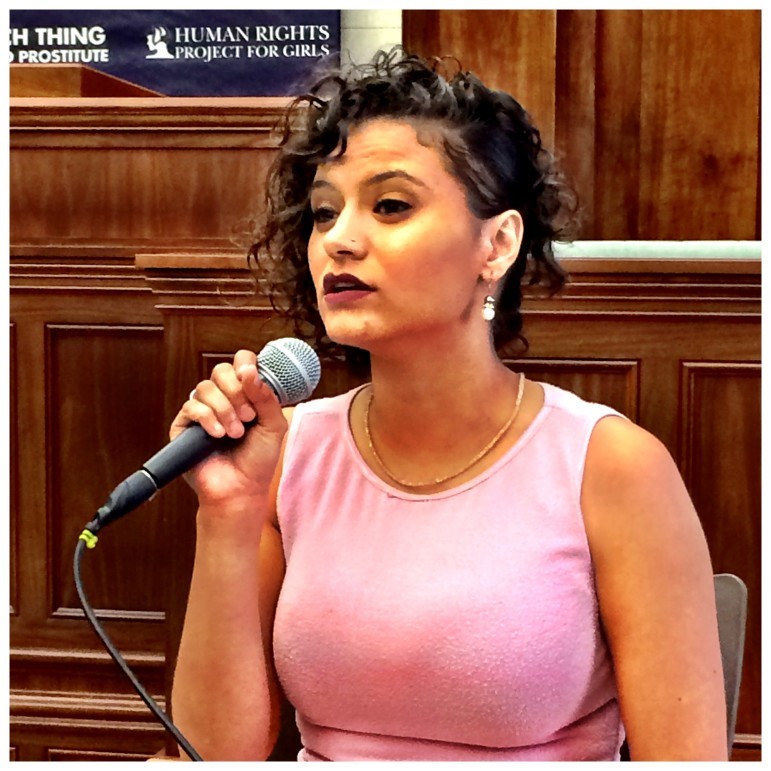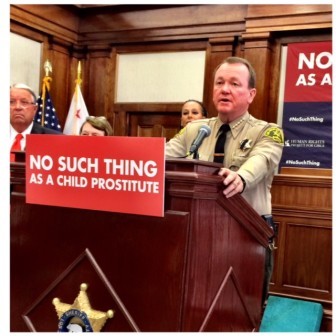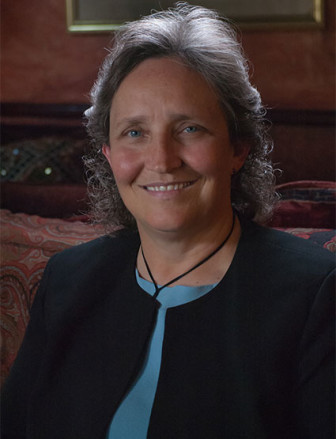
WitnessLA.com
Withelma “T” Ortiz Walker Pettigrew helps other survivors of child sex trafficking and works against trafficking as an advocate.
LOS ANGELES — Withelma “T” Ortiz Walker Pettigrew grew up in the foster care system in Los Angeles, where she lived in 14 different group homes, most of which featured various levels of abuse. Her experience showed her how children, in a system built to protect them, often face life-endangering risks that often go unnoticed by the public.
 Pettigrew and others have seen how cases of abuse in the foster care system can drive the children out of their group or foster homes in search of someone who can fill the painful void left in their lives by the lack of family, or any other kind of caring adult.
Pettigrew and others have seen how cases of abuse in the foster care system can drive the children out of their group or foster homes in search of someone who can fill the painful void left in their lives by the lack of family, or any other kind of caring adult.
“At the age of 10, I met a man that said he was going to love me, care for me, everything that I wanted someone to do, because I had no one,” Pettigrew said. But “love” and “care” turned out to have harrowing strings attached. “From the age of 10 to 17, I was employed here in California, from San Diego all the way up to Washington.”
By “employed,” Pettigrew means she was sexually abused for money as a victim of child sex trafficking.
For more information, visit the JJIE Resource Hub | Dual Status Youth
“I cannot remember my 10th through 13th birthdays,” she said. “My 14th birthday I was in Las Vegas. My 15th birthday I was in San Diego. My 16th I was on a break home, coming back from Washington. And my 17th I was in juvenile hall.”
Pettigrew's recruitment out of a group home was not unique.

WitnessLA.com
Los Angeles County Sheriff Jim McDonnell
“Seventy percent of the kids involved [in sex trafficking] we find locally are from foster care,” said Los Angeles County Sheriff Jim McDonnell. “They are kids who didn’t have much of a chance from an early age and now are revictimized by pimps.”
The California Child Welfare Council has similar numbers for the state, reporting that 50 to 80 percent of Commercially Sexually Exploited Children — or CSEC — have had child welfare involvement.

Charity Chandler-Cole
Charity Chandler-Cole, who is now on the board of the Anti-Recidivism Coalition, said she became aware of the issue of sex trafficking while living in her group home as a teenager. She watched as other children in the home would be released by staff to their pimp at night and let back into the group home hours later for a small fee. Other forms of prostitution, such as girls being used in pornographic videos, also took place, she said. All too soon, Chandler-Cole was introduced to those pimps and propositioned. She became a victim of sex trafficking.
“During my stay there, I was exploited in such a manner by the very people that were supposed to protect me,” she said. “I had no one to run to. I had nowhere to go because the system was the one violating me and so many others.”
Each year in the United States, more than 1,000 children are arrested as “child prostitutes,” even though they are not legally old enough to consent to sex. African-American children make up 59 percent of all prostitution-related arrests under the age of 18.
Los Angeles County is considered both a major hub and a transit route for sex-trafficked youth.
With all this in mind, last year the LA County Sheriff’s Department, the LA County Board of Supervisors and LA County Probation, plus the U.S. Justice Department and others launched a series of new strategies to address the disturbing problem of LA’s sex-trafficked children.
So what progress has been made?
The nature of the crime
According to McDonnell, sex-trafficking minors is a very profitable business. If a pimp has five girls operating every day, the sheriff said, he can make $600,000 to $800,000 per year.
“You sell dope once and it's gone. You can sell a person over and over again,” McDonnell said, his expression grim.
Girls are forced into horrific conditions and experiences so they can make the quota their pimps require for the day.
Prior to his election as Los Angeles County sheriff in 2014, McDonnell served as the second in command at the LA Police Department, and then the chief of the Long Beach (California) Police Department. During his time as chief in Long Beach, in particular, McDonnell saw that pimps were typically local gang members, 18 to 28 years old.
Unlike drug sales, this high-profit margin work is relatively low risk because of the internet, cellphones and the network of people involved, according to McDonnell.
Child sex trafficking isn’t an easy crime to spot, so many people still believe this is an international problem, he said. But “we found that the more we looked the more we found, very sadly.”
Sex trafficking has to occur somewhere, and often, McDonnell said, that “somewhere” is right next door, just out of sight, on the side of the road in an RV, in a motel room, hotel room or a vacant house.
Changing language to change minds
One of the problems with previous law enforcement strategies, said McDonnell and others, was the fact that victims of trafficking were those most likely to be arrested, not the traffickers or the customers who make the crime of trafficking children for sex profitable.
McDonnell and the LA County Board of Supervisors quickly embraced the strategy. Supervisor Sheila Kuehl explained at the launch of the No Such Thing campaign on Oct. 21 last year that, until very recently, she was told that arrest and incarceration were the only effective means of stabilizing commercially sexually exploited children.
“Fortunately, it’s not those experts we are listening to anymore,” Kuehl said. “Now we’re listening to the real experts, the people who have created the movement, the children themselves who have spoken and said, ‘No, it is not what we need to be locked behind bars, to be protected from exploiters and predators. That is not what we need for protection.’”
Through the insight the survivors provided, the existing approach was reformed to become victim- or child-centered.
Typically, when CSEC victims were caught in the past, they were arrested and treated as criminals because California does not have safe harbor laws, legislation that clearly states how sexually exploited children should be treated as victims, not prostitutes. This was an approach that victim advocates have opposed.

Michelle Guymon
Michelle Guymon, who is in charge of providing health and mentoring services for child sex-trafficking victims as director of placement administration services for Los Angeles County Probation, said the absence of such laws can be seen in a different light with a shift in protocol.
“I think what happens when you don’t have safe harbor is that people are motivated and passionate about doing the work and you can still make things happen,” Guymon said.
Legislation is not a magical solution, she explained. In fact, some of the states with safe harbor laws continue to arrest children for prostitution.
“I’m in meetings all the time with people from some of those states that have safe harbor. They still detain kids, and they’ve learned other ways around it,” Guymon said. “What came with safe harbor is no money for resources so they’re kind of stuck and are seeing some unintended consequences by not having programs set up.”
According to Guymon, Los Angeles has started rolling out programs so that when California does pass safe harbor legislation, the funding is secured and builds on what has already been started.
The three-prong solution
Last September, the LA Sheriff’s Department was able to take a big step forward with its strategy to combat the sex trafficking of children when it received a $1.5 million grant from the U.S. Department of Justice to fund the establishment of a multiagency Los Angeles Human Trafficking Task Force. The task force, a partnership of multiple federal, state and county agencies as well as community-based organizations, is designed to target the CSEC problem by using a three-pronged approach that is also victim-centered.

Alana Victor
The ceremonial ribbon-cutting at the kickoff for the new multiagency Los Angeles Human Trafficking Task Force.
The first of the three prongs involves going after the pimps and traffickers, using appropriate laws to identify, arrest and prosecute them.
With the second prong, the LASD and the task force aims to go after the demand side, “the johns,” the classic term used for buyers. McDonnell explained that, rather than citing the johns with prostitution charges for a small fine, as was the norm, the task force aims to indict them on charges of child molestation, statutory rape or conspiracy to commit either.
“So by doing that and publicizing what we are doing, we hope to create a disincentive so that people don’t engage in this behavior,” McDonnell said. “And we knock down the demand side so that there isn’t the tremendous profit that was fueling this all along.”
With the third prong, the task force identifies the victims, not as suspects, but as kids in need of rescue from their forced prostitution.
This third prong is being newly defined through the use of the Law Enforcement First Responder Protocol for Commercially Sexually Exploited Children, a system designed to identify victims of sexual exploitation at the first point of contact. Then law enforcement works collaboratively with county agencies and community-based organizations to avoid arresting the victim and to provide him or her with the services and resources they need to escape exploitation.
The new law enforcement protocol first began to be used on Aug. 15, 2014, by the Long Beach Police Department and the Compton Sheriff’s Station.
One year before the rollout, there were 94 arrests in Long Beach and Compton, according to Guymon. Since use of the protocol began, only two arrests for child prostitution have been made in this region.
The new alternatives to arrest have allowed for the proper treatment of these victims.
“[With the new approach] law enforcement has more options and avenues for responding so they aren’t stuck with what to do,” Guymon said. “All the knowledge and training, all the things we’ve done coming together has us doing things differently.”
Because of the regional success, she said, the LA County Board of Supervisors has decided to take the plan countywide.
“This task force is an opportunity to change the terrain and create a national model in how children should never be criminalized for being subject to repeated commercial rape,” said Malika Saada Saar, former executive director of Rights4Girls. “But naming it, responding to it, as a form of child rape, is absolutely needed.”
Responders provide victims with counseling and wraparound services to get them out of the life. However, some victims were arrested for this type of crime before this program began. For them, there is still hope in the form of a unique court system.
The STAR Court
The Los Angeles County Juvenile STAR Court (Succeeding Through Achievement and Resilience) is a partnership between the Los Angeles County Juvenile Court and the LA County Probation Department. It developed due to the increase in prostitution cases being filed in the delinquency courts, while some carried over to the child dependency courts too.
Under the program, minors arrested for involvement in prostitution are considered CSEC cases. This means, that even within the context of the legal process, they are viewed as victims, not criminals. The court aims to facilitate rehabilitation services for kids involved with CSEC so they are not retraumatized by court proceedings and incarceration.
STAR Court is in session once per week. It sees young women and young men who have been charged with prostitution or who have revealed involvement in prostitution after being arrested on other charges. These youths can volunteer to participate in the STAR court program during their probation so they can have access to rehabilitative and intervention services.
The court provides enhanced services and supervision for CSEC victims through a multidisciplinary team that includes the young person’s lawyer, the assistant district attorney, the assigned probation officer and advocates from community-based organizations that focus on sex-trafficked youth.
Though the original grant for this program ended in December 2014, the LA County Board of Supervisors voted in April 2015 to allocate county dollars to continue to fund the court.
“This is very noteworthy and something they need to be doing, so they found a way to make it work,” Guymon said. “It wasn’t one of those situations where the grant is over and they quit doing that program, but rather this is something that we continue to be very involved in.”
Nearly 80 percent of the girls involved with the STAR court had prior contact with the Los Angeles County Department of Children and Family Services, many with experiences like that of Pettigrew and Chandler-Cole. Programs like the STAR Court provide children with the support they often lacked in their homes, and again in the foster care system, according to Guymon.
“Something we see with those children in the foster care system, and coming out of it, is that they don’t have those positive support systems in their life,” Guymon said. “Once they have access to something like this, I think that makes a big difference.”
In her experience with STAR Court and probation, Guymon has seen kids form strong relationships, something they often never had before.
As a consequence, she said, the youngsters she has worked with over the years often look to her for support and continue to text her from time to time, asking for advice, or even a ride.
“I think what is really good for those youth or young adults is that they know there’s someone to reach out to,” Guymon said.

Alana Victor
McDonnell (left) and Pettigrew (at lectern) were at the announcement of the No Such Thing As a Child Prostitute campaign.
With these types of support systems, survivors like Pettigrew are eventually able to use their experiences to help other victims and also to teach the community about this troubling issue.
Pettigrew contacts survivors to begin to form the connections that will provide the support they need to begin to recover, the way crucial people reached out to her. She says sex-trafficking victims need to learn how to communicate and connect to get on the road to recovery.
“[For me] it started with one person saying ‘Hey, I care about you enough to actually answer the phone when you call,’” she said. “It is my honor to be able to take my experience and make something out of it.”
Educating the public
Another essential element of addressing the child sex-trafficking crisis, according to Sheriff McDonnell, is the task of informing the public.
“My goal, and a big part of this, is an education campaign,” McDonnell said. “To be able to educate the public as to what they could be looking for.” If properly informed, community members can be assets for law enforcement.
“We can really get the community engaged to be helpful to us,” McDonnell said. “It will save us a tremendous amount of time, surveillance, investigation, if the people and community can call us, say, ‘Hey, I’ve got a concern about this motel or whatever,’ because it focuses our resources that are very precious as it is, and it gives us an opportunity to intercede long before we might [otherwise] be able to.”
He explained that too often, people don’t make the call that could save a child’s life.
“We hear people say, ‘I knew something was going on but … I didn’t want to bother you,’” McDonnell said. “The message is, ‘You’re not bothering us, we want to hear from you and we want to be able to go out and look into these types of things, and we want to be able to have a good outcome.’”
According to the sheriff, education on sexually trafficked children also calls for a significant shift in perception.
McDonnell and community advocacy groups say there needs to be a societywide understanding that this is happening, not only on American soil, but in our neighborhoods.
“When we think about the issue of trafficking, we think about other countries. We think about children who are brought into this country as foreign nationals and bought and sold. And all of that is true … but in many if not most of our cities, those who are being bought and sold are our children, who are bought and sold for sex,” Saada Saar said.
McDonnell echoed this sentiment: “We have young people brought up in the United States of America, where traditionally we have not seen these problems, and certainly not to the degree to which we are seeing them today.”
Advocates like Pettigrew and community organizations focused on helping stop CSEC are calling for a shift in cultural opinion, starting with changing how society labels these children.
“It’s about breaking the lens, the misconception in society, and in the community. We have to stand up against these terms, against these labels,” Pettigrew said.
Maheen Kaleem, from the organization Rights4Girls, explains why there is reluctance to view young survivors of CSEC as victims of violence: “Before we talk about institutional barriers, the biggest issue is culture and attitude. We have to shift our attitude so that we can see these girls as victims and survivors as opposed to criminals because those attitude impact how we treat them.”
LA County has launched multiple public awareness campaigns and trained thousands of county employees to identify the warning signs. But the work has only just begun, according to Kaleem, McDonnell, Guymon and others.
“Our goal is to provide help and resources to those that are out there being victimized,” McDonnell said. “Truly, it will be a work in progress. But the tone is set, [and the] message is very clear.”
What’s next?

WitnessLA.com
Eileen Decker
Eileen Decker, the U.S. Attorney for the Central District of California, says a lot has been accomplished in the months since the task force launched last September.
“First, we have a group of organizations — the Los Angeles County Sheriff’s Department, the LAPD, the FBI, Homeland Security, the U.S. Attorney’s office, the DA’s office — who each individually have cared about this issue,” she said. “Now they’re working together, and that’s formidable.”
In addition, she said, “we’ve been able to do a lot of training since we received the funding. And that’s really important, so law enforcement are more equipped to understand what’s going on. That way it’s not, ‘Oh, there’s a young girl on that street corner.’ It’s about, ‘There’s a minor on a street corner who needs help,’ and there’s somebody behind that minor orchestrating what’s going on.’ These are children. The change in all these agencies to a victim-centered approach is critically important.”
But there’s much, much more still to be done, Decker said.
“More than anything,” she said, “we’ve got to protect these kids better at an earlier stage, whether it’s doing better [in] the juvenile justice system or in the foster care system. We have to have a better way of identifying the problem when it’s starting. And we have a long way to go, frankly. We need someone who’s going to say, ‘Not this kid.’ That’s a fundamental problem in that many of these young kids are in detention or in the foster care system through circumstances they didn’t create. And so there’s no one saying ‘Not this kid. I’m going to protect this kid at all costs.’
“And that’s not acceptable,” Decker said. “They’re our kids. Every one of them.”
This story is part of a series by reporters from the USC Annenberg School of Communication and Journalism. The series is part of a collaboration between the Juvenile Justice Information Exchange and WitnessLA.
This story has been updated.